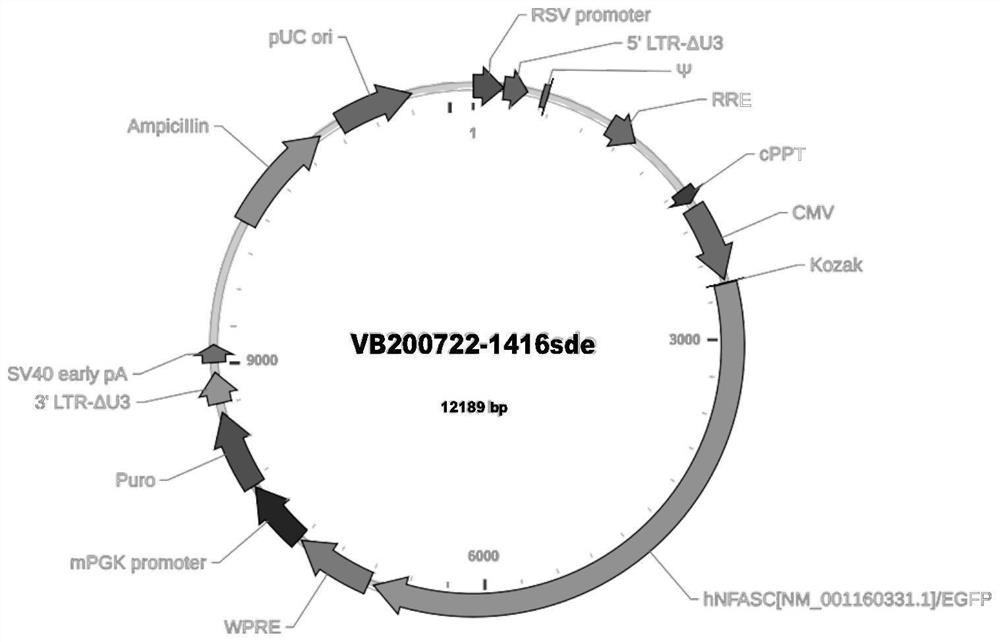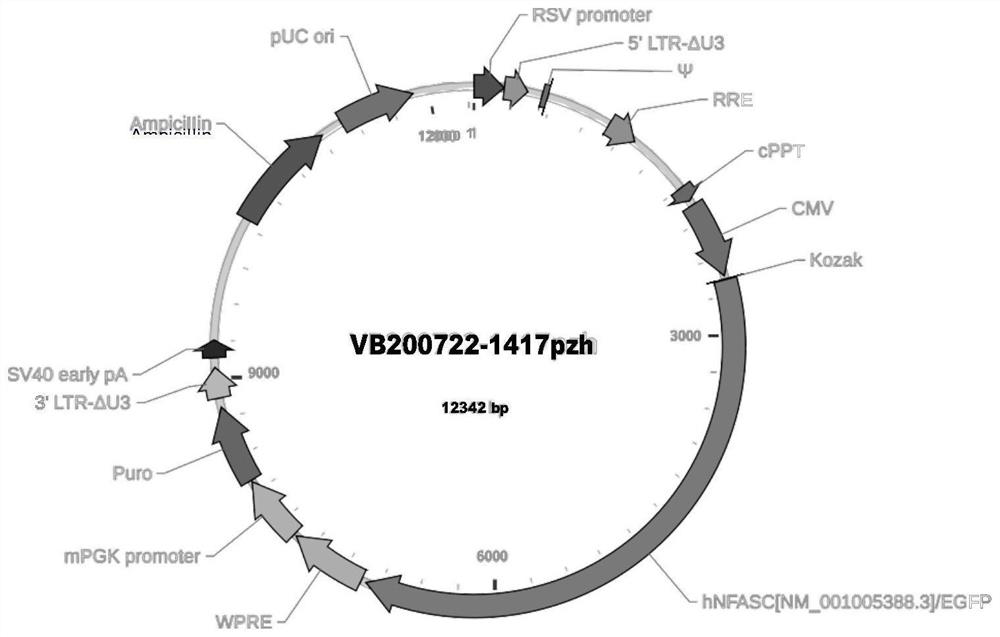Method for detecting nerve bundle protein NF155 and NF186 antibodies in serum and cerebrospinal fluid
A detection method, cerebrospinal fluid technology, applied in chemical instruments and methods, botany equipment and methods, biochemical equipment and methods, etc., can solve the problems of different detection rates and different transfection efficiencies, and improve detection sensitivity and accuracy sexual effect
- Summary
- Abstract
- Description
- Claims
- Application Information
AI Technical Summary
Problems solved by technology
Method used
Image
Examples
Embodiment 1
[0023] Plasmid construction:
[0024] 1.1 Utilize the homologous recombination method, the target gene NF155 of purification and NF186 are respectively mixed with carrier (such as figure 1 and figure 2 shown) ligation at 50°C for 70 min, and the ligation products were named pLV[Exp]-Puro-CMV>hNFASC[NM_001160331.1] / EGFP and pLV[Exp]-Puro-CMV>hNFASC[NM_001005388.3] / EGFP .
[0025] 1.2 Transform 50 μL supercompetent cells with 10 μL of the ligation product, mix the ligation product with the competent cells, and place on ice for 5 minutes. After heat shock at 42°C for 60 seconds, place it on ice for 1-2 minutes, add 500 μL of LB medium, 100 rpm, 37 Incubate on a constant temperature shaker at ℃ for 30 minutes, centrifuge at 3000 rpm for 2 minutes, discard 400 μL of the culture supernatant, mix the remaining 50-100 μL with a pipette and spread evenly on an LB plate containing 50 μg / mL ampicillin resistance, invert, and keep the temperature at 37 °C Incubate overnight in an incu...
Embodiment 2
[0028] Transfection:
[0029] 2.1 Plate 293T cells: trypsinize the cells and centrifuge and resuspend to plate. The plate requirements are to spread the cells evenly in a six-well plate, and place them in an incubator for overnight culture;
[0030] 2.2 Combine the target plasmid pLV[Exp]-Puro-CMV>hNFASC[NM_001160331.1] / EGFP and pLV[Exp]-Puro-CMV>hNFASC[NM_001005388.3 / EGFP obtained in Example 1 with the packaging plasmid pMDLg / pRRE respectively , PMD2.G, pRSV-Rev, mix according to the ratio of 8:8:2:2; add the plasmid dilution solution to Lipo 2000 dilution solution, mix gently and let stand at room temperature for 10 minutes;
[0031] 2.3 Replace the medium of the six-well plate in 2.1 with 1ml of new complete medium without antibiotics, then add the mixture obtained in 2.2 to each well of the six-well plate and gently shake the cell plate back and forth to make the mixture and Mix the culture solution in the well, culture in a 37°C cell CO2 incubator for 1-3 days, observe t...
Embodiment 3
[0038] divert:
[0039] 3.1 Make the cell density 1-2*10 5 Inoculate the 293T cell suspension per ml into a six-well plate (the confluence of the target cells should be 30%-50% during transduction), and place it in a carbon dioxide incubator at 37°C and 5% CO2 for 18-20 hours;
[0040] 3.2 The initial MOI of the transduced cells is set to 5; thaw the frozen virus solution on ice, mix the thawed virus particles, and use a 6-well plate for transduction; take 10ul>10 8 Add TU / ml virus solution to 1ml culture medium, then mix gently; add 5μg / ml Polybrene at the same time to enhance the binding of pseudovirus capsid and cell membrane; add 0.02g / ml sodium cromoglycate solution at the same time to maintain the cell membrane stability and reduce cell inflammatory response;
[0041]3.3 After 24 hours, suck out the original medium in 3.1, then add the virus-containing medium in 3.2 to the cells, shake the culture plate gently so that the virus liquid can cover every cell, and then pla...
PUM
 Login to View More
Login to View More Abstract
Description
Claims
Application Information
 Login to View More
Login to View More - R&D
- Intellectual Property
- Life Sciences
- Materials
- Tech Scout
- Unparalleled Data Quality
- Higher Quality Content
- 60% Fewer Hallucinations
Browse by: Latest US Patents, China's latest patents, Technical Efficacy Thesaurus, Application Domain, Technology Topic, Popular Technical Reports.
© 2025 PatSnap. All rights reserved.Legal|Privacy policy|Modern Slavery Act Transparency Statement|Sitemap|About US| Contact US: help@patsnap.com



